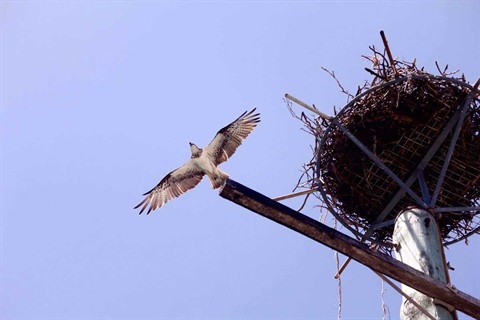Nesting Osprey can view drones as predators
12 July 2018

Drones add to obstacles to breeding for Osprey
Winter is the perfect time to head to the beach. As well as being great for Humpback whale spotting during their annual migration north, another iconic coastal species, the Osprey is busy nesting and raising its young in the Tweed.
Unfortunately, the often difficult nesting period can be placed under threat by a number of factors, including drones.
Birdlife Northern Rivers’ Tweed Osprey Group volunteers monitor the breeding success of local Ospreys annually and they have found Osprey pairs generally attempt to breed each year but are not always successful.
Problems faced during the breeding period include exposure to extreme weather, storm damage to nests, predation of eggs and chicks by other birds such as Crows and White-bellied Sea Eagles, entanglement in fishing line and disturbance to nesting, including by drones and model aircraft.
Council’s Threatened Species Project Officer Tanya Fountain said a drone may be perceived as a possible predator by an Osprey.
“If a parent bird is preoccupied with defending their nest from a drone, it could result in neglect of vulnerable eggs and chicks, reducing breeding success. Birds that attack drones could also be injured by moving blades,” Ms Fountain said.
Responsible use of drones can go a long way to minimising any negative impacts to nesting Ospreys.”
Recreational drone users should always keep their vehicles away from wildlife and obey the Civil Aviation Safety Authorities recreational drone safety rules. Recreational drone users are also reminded that the Osprey is listed as a threatened species under the NSW Biodiversity Conservation Act. Under this Act it is an offence to harm or attempt to harm a threatened species.
“Ospreys are listed as vulnerable to extinction in NSW largely due to the loss of natural nesting sites – being big old trees along the coast. Construction of artificial nest structures, like the very familiar cradle at the Marine Rescue tower on Cudgen Creek, Kingscliff, are the only reason Ospreys continue to breed in the Tweed.”
Osprey incubate their eggs from May of each year. Nestlings are fed and are totally dependent on parents through to October. Around this time, young take their first flights but are still dependent on parents for some time. It is this period, from May to October that is vital to minimise disturbance to nesting pairs.
“Osprey monitors report that it is not always easy to see what's happening in a nest but regular observers on the ground will see the incubating adult sitting very low in the nest, then eventually one to as many as three little heads occasionally pop up,” Ms Fountain said.
“Adults regularly bring fish to the nest and feed chicks, and eventually big chicks that look very much like their parents stretch their wings in preparation for fledging (flying).“
To report harm to a threatened species in the Tweed region contact the NSW Office of Environment’s Tweed Area office on (02) 6670 8600. For more information about Birdlife Northern Rivers and the Osprey monitoring program go to www.birdlife.org.au/locations/birdlife-northern-nsw/birdlife-northern-rivers or contact Tweed Shire Council’s Threatened Species Project Officer Tanya Fountain on (02) 6670 2400.
Downloads
Photo 1(JPG, 86KB)
Caption: An adult Osprey at the artificial nest at Cudgen Creek at Kingscliff